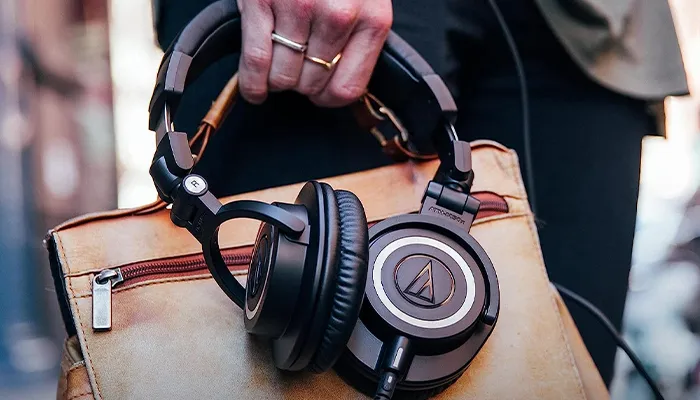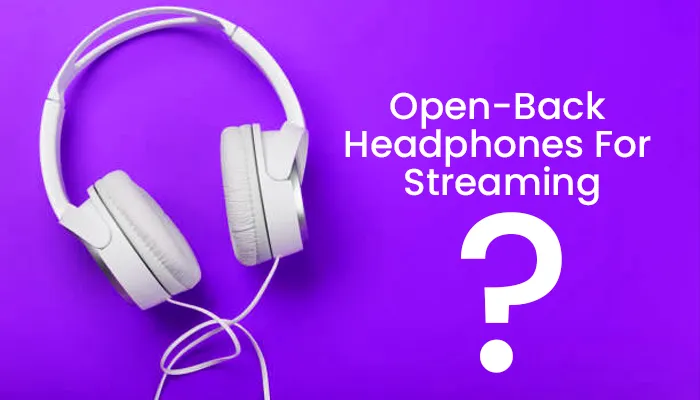So you finally decided to invest in a pair of high-quality headphones for streaming music, gaming, or watching movies. Now you’re wondering if open-back or closed-back headphones are the way to go. Open-back headphones have an open design that allows air and sound to pass through, creating a wider and more natural soundstage.
The downside is that they leak sound, so they’re not ideal if you have a noisy environment or nosy neighbors. Closed-back headphones have an isolated design that contains the sound within the earcups. They offer more privacy but can have a narrower soundstage.
What Are Open-Back Headphones?
Open-back headphones, as the name suggests, have an open design rather than sealed ear cups. This means the outer casing is perforated or mesh-covered, allowing air flow and sound to pass through.
For streaming, open-back cans can be a great choice. They typically provide a more natural, spacious sound with wider soundstages. You’ll get an airier, less congested listening experience, which many find ideal for long streaming sessions.
The open design does mean less noise isolation, so outside sounds can still be heard and your audio may disturb others nearby. If total immersion or privacy is important, closed-back headphones may be better.
Open-back headphones also tend to leak more sound, so if you like to crank up the volume, choose a pair marketed as having “minimum sound leakage”. Look for terms like ‘acoustic transparency’ or ‘open-air design’ which indicate more mesh or perforation and a wider, airier sound.
Popular open-back Headphone brands for streaming include:
- Sennheiser
- Beyerdynamic
- Grado
- HiFiMan
With the right open-back headphones, streaming your favorite tunes, podcasts and more can be an expansive experience. Just be mindful of any sound leakage – your guilty streaming pleasures may no longer be a secret!
Related: Best Open-Back Headphones For Streaming 2023 Click here to View.

Why Open-Back Headphones Good for Streaming?
Open-back headphones are ideal for streaming audio for a few reasons:
Superior Sound Quality
Open-back headphones provide a wider, more natural soundstage that creates an immersive listening experience perfect for enjoying streamed music or podcasts. The open design allows sound to flow freely, so you’ll hear details you never noticed before with closed-back models.
More Comfortable for Long Listening
The open design is lighter and more breathable, so your ears won’t get hot or fatigued during long streaming sessions. The spacious, open feel is just more pleasant for extended listening.
Connects You to Your Environment
Open-back headphones allow ambient noise in and out, so you can still hear what’s going on around you. You won’t feel as isolated, which some people prefer. This can be good when you want to remain aware of your surroundings.
While open-back headphones may leak more sound and provide less noise isolation, many audiophiles believe the enhanced audio experience they enable is worth it, especially for enjoying streamed media.
When superior sound quality, long-term comfort, and environmental awareness are priorities, open-back headphones have the advantage.

Considerations for Streaming with Open Back Headphones
Open-back headphones can be a great choice for streaming, but there are a few things to keep in mind.
Sound Quality
The open design provides an expansive soundstage, giving music a more natural, airy quality. You’ll be able to pick out subtle details in your favorite tracks.
However, the open back also means more sound leakage – others around you may be able to hear what you’re listening to. If you plan on streaming in close proximity to others, closed-back headphones may be more considerate.
Comfort
The open back allows for better ventilation and less buildup of heat and pressure. This can lead to improved long term comfort during streaming sessions.
The lightweight, breathable design reduces ear fatigue and irritation over extended periods of use. If comfort is a priority, open-back headphones are an excellent option for streaming media and listening to music.
Microphone Pickup
The open back design allows ambient noise to enter the headphones, which can also mean your microphone may pick up more background noise.
If you plan on chatting or gaming while streaming, a noise-canceling microphone may be needed to reduce the amount of extraneous noise transmitted to others. Some open-back headphones also provide an attachable boom mic to help minimize background interference.
While open-back headphones provide some advantages for streaming like an expansive soundstage and enhanced comfort, there are a few drawbacks to be aware of like increased sound leakage, ambient noise pickup and microphone interference.
By choosing a high-quality pair of open-back headphones and making some minor adjustments, you can enjoy an optimal streaming experience with all the benefits of an open acoustic design.

Cons of Open-Back Headphones for Streaming
Open-back headphones, while great for comfort and sound quality, aren’t ideal for streaming media. The open design that creates an expansive soundstage also means that sound leaks in and out. This can be distracting for you and anyone around you.
If you stream in a shared space or don’t want sound pollution, open-back headphones may not be the best choice. The audio coming through the headphones can be heard by others, and outside noises can intrude on your listening experience.
For private, immersive streaming, closed-back or noise-canceling headphones are better options.
Open-back headphones also typically don’t provide the powerful bass of closed-back models. If you listen to music genres like EDM, hip hop or action movies and games with heavy bass, open-back headphones may lack the low-end punch you want.
The open design prevents the buildup of air pressure that helps closed-back headphones produce a solid bass response.
While open-back headphones offer some advantages for critical listening, their downsides for casual streaming media in shared spaces are significant. If sound isolation, privacy and powerful bass are important, you’ll likely be happier with a different style of headphone for streaming music, movies, TV shows and gameplay.
For the best all-around streaming experience, closed-back or noise-canceling headphones are worth considering.

What to Look for in Open-Back Headphones for Streaming
When shopping for open-back headphones specifically for streaming music or other audio, there are a few key things to consider:
Comfort is key. Look for headphones with padded ear cups and an adjustable headband. You’ll likely be wearing them for long periods, so they need to be comfortable.
Sound quality matters. Open-back headphones provide an open, airy sound quality with a wider soundstage. Look for a frequency response range of at least 20 Hz to 20 kHz to provide full, balanced audio. More premium drivers, like neodymium magnets, often produce better quality sound.
Leakage is a factor. The open-back design means sound will leak in and out. If you plan to use them in a quiet space or don’t mind the leakage, open-back headphones can be a great choice. If you need isolation, closed-back may be better.
Wired or wireless. Choose between wired headphones that provide lossless audio quality or wireless Bluetooth headphones for more convenience. If going wireless, look for at least Bluetooth 5.0 and a long battery life.
An in-line mic is useful. For streaming music or taking calls, an in-line microphone lets you easily control playback or answer calls without taking off your headphones.
Price varies. You can find open-back headphones for under $50 up to $500 or more for premium audiophile-grade headphones. Set a budget and stick to it based on your needs.

Tips on How to Create the Best Listening Environment when Using Open-Back Headphones
To get the best listening experience from your open-back headphones, consider these tips for creating an optimal environment:
Find a quiet space
Since open-back headphones don’t block out ambient noise, choose a quiet room away from external sounds. A closed-door office or bedroom is ideal. Libraries or lounges can work in a pinch. The less background noise, the better.
Sit still
Because open-back headphones don’t isolate the sound, moving around a lot can disrupt your listening. Find a comfortable chair or sofa and sit in one place while streaming. Subtle head movements are fine, but avoid walking or doing physical activities.
Keep a low volume
With open-back headphones, the sound leaks out, and the noise around you leaks in. To avoid disturbing others nearby, keep the volume at a moderate level. You’ll still get an immersive experience, just at a respectful volume.
Consider your positioning
How you position the open-back headphones on your ears can impact the sound quality. For the best balance of audio and comfort, place the headphones directly over your ears. Experiment with different angles and find what sounds best to you based on the design.
Take breaks
While open-back headphones provide an open, natural listening experience, prolonged use can lead to fatigue. Take short breaks every 30-60 minutes to rest your ears. Staying in one position for too long isn’t ideal. Stand up, move around and give your ears a break. Your listening experience will be better for it.
Quality vs. Comfort
When it comes to streaming audio, open-back headphones offer some pros and cons to consider in the quality vs. comfort debate.
Sound Quality
Open-back headphones typically provide a wider, more natural soundstage since the open design allows sound to flow freely. This can make music, movies and games feel more immersive. The open design also reduces resonance and distortion. However, the open-back allows more ambient noise in and sound leaks out, which can be distracting for you and others.
Comfort
The open-back design is often more comfortable for long listening sessions since your ears can breathe and don’t get hot or sweaty. The lightweight, breathable design reduces pressure and minimizes ear fatigue. However, some ambient noise and sound leakage may be distracting or annoying for some.
In the end, you need to weigh what factors matter most to you – stellar sound quality, maximum comfort, or a mix of both. If high-resolution, audiophile-quality audio is most important, open-back headphones are an ideal choice. If you need to block out noise or don’t want sound to disturb others nearby, you’re better off with closed-back headphones. For the best of both worlds, consider a pair of open-back headphones for at-home listening and a pair of closed-back headphones for on-the-go.
Open-Back Vs. Closed-Back Headphones for Streaming
When it comes to streaming music or watching videos, open-back headphones can provide some advantages over closed-back models. Open-back headphones have perforated ear cups that allow some outside noise in and let the sound from the headphones out. This can make them a good choice for streaming at home.
Sound Quality
Open-back headphones typically have a wider, more spacious soundstage that can make music and movies seem more immersive. The open design also often provides clearer, more natural sound with fuller bass. If high-fidelity audio is most important to you, open-back headphones are probably your best bet for streaming.
Comfort
The open-back design prevents pressure buildup in your ears that can lead to discomfort over long listening sessions. Your ears can breathe, so to speak. Open-back headphones also don’t isolate you from your environment, so you’ll still be aware of sounds around you. This can be good if you want to stay aware of what’s going on in your home.
Of course, the open-back design isn’t for everyone or every situation. If outside noise is an issue or you need privacy, closed-back headphones may be better for streaming. But for casual listening at home, the spacious, natural sound and added comfort of open-back headphones can make them an excellent choice.
Conclusion
So are open-back headphones the best choice for streaming your favorite music and podcasts? That depends on what’s most important to you. If sound quality and an open, spacious soundstage are your top priorities, open-back headphones are a great option.
But if you need good noise isolation or want headphones that won’t leak sound to those around you, closed-back headphones are probably better suited. As with many technology choices, it comes down to balancing performance, features, and your own needs and preferences.
The good news is there are great options for every listening style. So choose what sounds good to you, queue up your favorite playlist, and enjoy!
- Charging Bluetooth Headphones During Use: Is It Possible? - January 9, 2024
- Why Over-Ear Headphones Best for Hearing Health? (7 Reasons) - December 12, 2023
- Fixing the Bose Earbuds Not Charging in Case Problem: Solutions That Work - November 24, 2023

